Muscle Function and Kinematics during Submaximal Equine Jumping: What Can Objective Outcomes Tell Us about Athletic Performance Indicators?
Abstract
:Simple Summary
Abstract
1. Introduction
2. Materials and Methods
2.1. Horses
2.2. Instrumentation and Equipment Set Up
2.3. Data Acquisition Protocol
Jumping Trial Protocol
2.4. Kinematic Data Processing and Analysis
2.5. sEMG Data Processing and Analysis
2.6. Statistical Analysis
3. Results
3.1. Kinematic Examination of Equestrian Performance Indicators
3.2. Muscle Activity Patterns during Jumping
3.2.1. Middle Gluteal
3.2.2. Biceps Femoris
3.2.3. Triceps Brachii
3.3. Relationships between Significant Muscle Function and Jumping Performance Indicators
4. Discussion
4.1. Movement and Hindlimb Muscle Activation Strategies That Facilitate Impulsion and Engagement Represent Key Jumping Performance Indicators
Relationships between Hindlimb Muscle Activation and Kinematic Measures of Impulsion and Engagement
4.2. Forelimb Joint Articulation and Triceps Muscle Activation Strategies Do Not Differentiate Jumping Performance over Submaximal Fences
Relationships between Triceps Muscle Activation and Kinematic Measures Forelimb Joint/Segment Movement
4.3. Study Limitations and Additional Considerations
5. Conclusions
Supplementary Materials
Author Contributions
Funding
Institutional Review Board Statement
Data Availability Statement
Acknowledgments
Conflicts of Interest
References
- Fédération Equestre Internationale. Main Jumping. Available online: https://inside.fei.org/fei/disc/jumping (accessed on 11 August 2020).
- Federation Equestre Internationale. FEI World of Sport-FEI Annual Report 2019. Available online: https://inside.fei.org/fei/about-fei/publications/fei-annual-report/2019/feiworldofsport/ (accessed on 11 August 2020).
- Górecka-Bruzda, A.; Chruszczewski, M.H.; Jaworski, Z.; Golonka, M.; Jezierski, T.; Długosz, B.; Pieszka, M. Looking for an ideal horse: Rider preferences. Anthrozoös 2011, 24, 379–392. [Google Scholar] [CrossRef]
- Fédération Equestre Internationale. Jumping Rules. Available online: https://inside.fei.org/sites/default/files/Jumping_Rules_2020_clean.pdf (accessed on 11 August 2020).
- Cassiat, G.; Pourcelot, P.; Tavernier, L.; Geiger, D.; Denoix, J.M.; Degueurce, D. Influence of individual competition level on back kinematics of horses jumping a vertical fence. Equine Vet. J. 2004, 36, 748–753. [Google Scholar] [CrossRef]
- Bobbert, M.F.; Santamaría, S.; van Weeren, P.R.; Back, W.; Barneveld, A. Can jumping capacity of adult show jumping horses be predicted on the basis of submaximal free jumps at foal age? A longitudinal study. Vet. J. 2005, 170, 212–221. [Google Scholar] [CrossRef] [PubMed]
- Santamaría, S.; Bobbert, M.F.; Back, W.; Barneveld, A.; van Weeren, P.R. Effect of early training on the jumping technique of horses. Am. J. Vet. Res. 2005, 66, 418–424. [Google Scholar] [CrossRef]
- Santamaría, S.; Back, W.; Van Weeren, P.; Knaap, J.; Barneveld, A. Jumping characteristics of naive foals: Lead changes and description of temporal and linear parameters. Equine Vet. J. 2002, 34, 302–307. [Google Scholar] [CrossRef]
- Clayton, H.M. Time-motion analysis of show jumping competitions. J. Equine Vet. Sci. 1996, 16, 262–266. [Google Scholar] [CrossRef]
- Smith, R.; Birch, H.; Patterson-Kane, J.; Firth, E.; Williams, L.; Cherdchutham, W.; Van Weeren, P.R.; Goodship, A. Should equine athletes commence training during skeletal development?: Changes in tendon matrix associated with development, ageing, function and exercise. Equine Vet. J. 1999, 31, 201–209. [Google Scholar] [CrossRef]
- St George, L.; Hobbs, S.J.; Sinclair, J.; Richards, J.; Roddam, H. Does equestrian knowledge and experience influence selection and training practices for showjumping horses? Comp. Exerc. Physiol. 2019, 15, 123–135. [Google Scholar] [CrossRef]
- Williams, J. Performance analysis in equestrian sport. Comp. Exerc. Physiol. 2013, 9, 67–77. [Google Scholar] [CrossRef]
- Hughes, M.D.; Bartlett, R.M. The use of performance indicators in performance analysis. J. Sports Sci. 2002, 20, 739–754. [Google Scholar] [CrossRef]
- Santamaría, S.; Bobbert, M.F.; Back, W.; Barneveld, A.; van Weeren, P.R. Evaluation of consistency of jumping technique in horses between the ages of 6 months and 4 years. Am. J. Vet. Res. 2004, 65, 945–950. [Google Scholar] [CrossRef] [PubMed]
- Van den Bogert, A.; Jansen, M.O.; Deuel, N.R. Kinematics of the hind limb push-off in elite show jumping horses. Equine Vet. J. 1994, 26, 80–86. [Google Scholar] [CrossRef]
- Powers, P.; Harrison, A. A study on the techniques used by untrained horses during loose jumping. J. Equine Vet. Sci. 2000, 20, 845–850. [Google Scholar] [CrossRef]
- Schambardt, H.; Merkens, H.; Vogel, V.; Willekens, C. External loads on the limbs of jumping horses at take-off and landing. Am. J. Vet. Res. 1993, 54, 675–680. [Google Scholar]
- Colborne, G.; Clayton, H.M.; Lanovaz, J. Factors that influence vertical velocity during take off over a water jump. Equine Vet. J. 1995, 27, 138–140. [Google Scholar] [CrossRef]
- Powers, P. Equestrian: Linear kinematics at take-off in horses jumping the wall in an international Puissance competition. Sports Biomech. 2005, 4, 149–162. [Google Scholar] [CrossRef]
- Lewczuk, D.; Wejer, J.; Sobieraj, D. Analysis of angles of taking off, landing, and work of limbs in horses jumping above the spread obstacle of different structure. Anim. Sci. Pap. Rep. 2007, 25, 297–304. [Google Scholar]
- Barrey, E.; Blanchard, G.; Orange, F. Influence of the level of competition, breed, sex, and genetic factors on stride kinematics of show jumping horses. In Proceedings of the 12th Meeting of the Association for Equine Sports Medicine, Fallbrook, CA, USA, 13–16 March 1993; pp. 13–16. [Google Scholar]
- Clayton, H.M.; Barlow, D.A. The effect of fence height and width on the limb placements of show jumping horses. J. Equine Vet. Sci. 1989, 9, 179–185. [Google Scholar] [CrossRef]
- Clayton, H.M.; Colborne, G.R.; Burns, T.E. Kinematic analysis of successful and unsuccessful attempts to clear a water jump. Equine Vet. J. 1995, 27, 166–169. [Google Scholar] [CrossRef]
- Lewczuk, D. Effect of the judge and definition of the trait for horse free jumping evaluation. Arch. Anim. Breed. 2013, 56, 638–649. [Google Scholar] [CrossRef] [Green Version]
- Barrey, E.; Galloux, P. Analysis of the equine jumping technique by accelerometry. Equine Vet. J. 1997, 29, 45–49. [Google Scholar] [CrossRef]
- Santamaría, S.; Bobbert, M.F.; Back, W.; Barneveld, A.; van Weeren, P.R. Variation in free jumping technique within and among horses with little experience in show jumping. Am. J. Vet. Res. 2004, 65, 938–944. [Google Scholar] [CrossRef]
- Galloux, P.; Barrey, E. Components of the total kinetic moment in jumping horses. Equine Vet. J. 1997, 29, 41–44. [Google Scholar] [CrossRef]
- Harrison, S.M.; Whitton, R.C.; King, M.; Haussler, K.K.; Kawcak, C.E.; Stover, S.M.; Pandy, M.G. Forelimb muscle activity during equine locomotion. J. Exp. Biol. 2012, 215, 2980–2991. [Google Scholar] [CrossRef] [Green Version]
- Jansen, M.; van Raaij, J.; Van den Bogert, A.; Schamhardt, H.; Hartman, W. Quantitative analysis of computer-averaged electromyographic profiles of intrinsic limb muscles in ponies at the walk. Am. J. Vet. Res. 1992, 53, 2343–2349. [Google Scholar]
- Zsoldos, R.; Kotschwar, A.; Kotschwar, A.; Groesel, M.; Licka, T.; Peham, C. Electromyography activity of the equine splenius muscle and neck kinematics during walk and trot on the treadmill. Equine Vet. J. 2010, 42, 455–461. [Google Scholar] [CrossRef] [PubMed]
- Zsoldos, R.; Kotschwar, A.; Kotschwar, A.; Rodriguez, C.; Peham, C.; Licka, T. Activity of the equine rectus abdominis and oblique external abdominal muscles measured by surface EMG during walk and trot on the treadmill. Equine Vet. J. 2010, 42, 523–529. [Google Scholar] [CrossRef] [PubMed]
- St George, L.; Roy, S.; Richards, J.; Sinclair, J.; Hobbs, S.J. Surface EMG signal normalisation and filtering improves sensitivity of equine gait analysis. Comp. Exerc. Physiol. 2019, 15, 173–185. [Google Scholar] [CrossRef]
- Robert, C.; Valette, J.; Degueurce, C.; Denoix, J. Correlation between surface electromyography and kinematics of the hindlimb of horses at trot on a treadmill. Cells Tissues Organs 1999, 165, 113–122. [Google Scholar] [CrossRef] [PubMed]
- Licka, T.; Frey, A.; Peham, C. Electromyographic activity of the longissimus dorsi muscles in horses when walking on a treadmill. Vet. J. 2009, 180, 71–76. [Google Scholar] [CrossRef]
- Licka, T.F.; Peham, C.; Frey, A. Electromyographic activity of the longissimus dorsi muscles in horses during trotting on a treadmill. Am. J. Vet. Res. 2004, 65, 155–158. [Google Scholar] [CrossRef] [PubMed]
- St George, L.; Williams, J. Electromyographic evaluation of approach stride, jump stride and intermediate stride in selected superficial muscles of the jumping horse: A preliminary study. Comp. Exerc. Physiol. 2013, 9, 23–32. [Google Scholar] [CrossRef]
- Giovagnoli, C.; Pieramati, G.; Castellano, G.; Reitano, M.; Silvestrelli, M. Analysis of neck muscle (Splenius) activity during jumping by surface video-electromyography technique. In Proceedings of the Conference on Equine Sports Medicine and Science (CESMAS), Cordoba, Spain, 24–26 April 1998; pp. 57–60. [Google Scholar]
- St George, L.; Hobbs, S.J.; Richards, J.; Sinclair, J.; Holt, D.; Roy, S. The effect of cut-off frequency when high-pass filtering equine sEMG signals during locomotion. J. Electromyogr. Kinesiol. 2018, 43, 28–40. [Google Scholar] [CrossRef]
- Bobbert, M.F.; Santamaría, S. Contribution of the forelimbs and hindlimbs of the horse to mechanical energy changes in jumping. J. Exp. Biol. 2005, 208, 249–260. [Google Scholar] [CrossRef] [Green Version]
- Winfield, J. What industry requires from the application of research from equine science. Adv. Anim. Biosci. 2010, 1, 351. [Google Scholar] [CrossRef] [Green Version]
- McGarry, T. Applied and theoretical perspectives of performance analysis in sport: Scientific issues and challenges. Int. J. Perform. Anal. 2009, 9, 128–140. [Google Scholar] [CrossRef]
- Robert, C.; Audigié, F.; Valette, J.; Pourcelot, P.; Denoix, J.M. Effects of treadmill speed on the mechanics of the back in the trotting saddlehorse. Equine Vet. J. 2001, 33, 154–159. [Google Scholar] [CrossRef]
- Hodson-Tole, E. Effects of treadmill inclination and speed on forelimb muscle activity and kinematics in the horse. Equine Comp. Exerc. Physiol. 2006, 3, 61–72. [Google Scholar] [CrossRef]
- Schuurman, S.O.; Kersten, W.; Weijs, W.A. The equine hind limb is actively stabilized during standing. J. Anat. 2003, 202, 355–362. [Google Scholar] [CrossRef] [PubMed]
- Zaneb, H.; Kaufmann, V.; Licka, T.; Peham, C.; Stanek, C. Determination of position of surface electromyographic electrodes for selected equine muscles. In Proceedings of the Noraxon EMG Meeting 2007, Münster, Germany, 19–24 May 2007; pp. 14–15. [Google Scholar]
- Cram, J.R.; Rommen, D. Effects of skin preparation on data collected using an EMG muscle-scanning procedure. Biofeedback Self-Regul. 1989, 14, 75–82. [Google Scholar] [CrossRef] [PubMed]
- Clancy, E.A.; Morin, E.L.; Merletti, R. Sampling, noise-reduction and amplitude estimation issues in surface electromyography. J. Electromyogr. Kinesiol. 2002, 12, 1–16. [Google Scholar] [CrossRef]
- Hermens, H.J.; Freriks, B.; Disselhorst-Klug, C.; Rau, G. Development of recommendations for SEMG sensors and sensor placement procedures. J. Electromyogr. Kinesiol. 2000, 10, 361–374. [Google Scholar] [CrossRef]
- De Luca, C.J. The use of surface electromyography in biomechanics. J. Appl. Biomech. 1997, 13, 135–163. [Google Scholar] [CrossRef] [Green Version]
- Clayton, H.M.; can Weeren, P.R. Performance in Equestrian Sports. In Equine Locomotion, 2nd ed.; Back, W., Clayton, H.M., Eds.; Elsevier: Amserdam, The Netherlands, 2013; pp. 305–340. [Google Scholar]
- Hobbs, S.J.; Richards, J.; Clayton, H.M. The effect of centre of mass location on sagittal plane moments around the centre of mass in trotting horses. J. Biomech. 2014, 47, 1278–1286. [Google Scholar] [CrossRef] [PubMed]
- Holt, D.; St George, L.; Clayton, H.; Hobbs, S.J. A simple method for equine kinematic gait event detection. Equine Vet. J. 2017, 49, 688–691. [Google Scholar] [CrossRef] [Green Version]
- Clayton, H.M. Terminology for the description of equine jumping kinematics. J. Equine Vet. Sci. 1989, 9, 341–348. [Google Scholar] [CrossRef]
- FEI. Dressage Handbook-Guidelines for Judging; FEI: Lausanne, Switzerland, 2007. [Google Scholar]
- Biewener, A.A. Allometry of quadrupedal locomotion: The scaling of duty factor, bone curvature and limb orientation to body size. J. Exp. Biol. 1983, 105, 147–171. [Google Scholar]
- Back, W.; Schamhardt, H.; Savelberg, H.; Van den Bogert, A.; Bruin, G.; Hartman, W.; Barneveld, A. How the horse moves: 1. Significance of graphical representations of equine forelimb kinematics. Equine Vet. J. 1995, 27, 31–38. [Google Scholar] [CrossRef]
- Back, W.; Schamhardt, H.; Savelberg, H.; Van Den Bogert, A.; Bruin, G.; Hartman, W.; Barneveld, A. How the horse moves: 2. Significance of graphical representations of equine hind limb kinematics. Equine Vet. J. 1995, 27, 39–45. [Google Scholar] [CrossRef] [PubMed]
- Bonato, P.; D’Alessio, T.; Knaflitz, M.A. Statistical method for the measurement of muscle activation intervals from surface myoelectric signal during gait. IEEE Trans. Biomed. Eng. 1998, 45, 287–299. [Google Scholar] [CrossRef]
- Merlo, A.; Farina, D.; Merletti, R. A fast and reliable technique for muscle activity detection from surface EMG signals. IEEE trans. Biomed. Eng. 2003, 50, 316–323. [Google Scholar] [CrossRef]
- Bullock-Saxton, J.E. Local sensation changes and altered hip muscle function following severe ankle sprain. Phys. Ther. 1994, 74, 17–28. [Google Scholar] [CrossRef] [PubMed] [Green Version]
- Bogey, R.A.; Barnes, L.A.; Perry, J. Computer algorithms to characterize individual subject EMG profiles during gait. Arch. Phys. Med Rehabil. 1992, 73, 835–841. [Google Scholar] [CrossRef]
- Clayton, H.; Barlow, D. Stride characteristics of four Grand Prix jumping horses. Equine Exerc. Phys. 1991, 3, 151–157. [Google Scholar]
- Patil, S.; Dixon, J.; White, L.C.; Jones, A.P.; Hui, A.C. An electromyographic exploratory study comparing the difference in the onset of hamstring and quadriceps contraction in patients with anterior knee pain. Knee 2011, 18, 329–332. [Google Scholar] [CrossRef] [PubMed]
- Vera, M.J.; Dubravka, B.; Nikola, J.; Vojin, I.; Bojana, P.-B. Detecting and removing outlier (s) in electromyographic gait-related patterns. J. Appl. Stat. 2013, 40, 1319–1332. [Google Scholar] [CrossRef]
- Stålberg, E.; Bischoff, C.; Falck, B. Outliers, a way to detect abnormality in quantitative EMG. Muscle Nerve 1994, 17, 392–399. [Google Scholar] [CrossRef] [PubMed]
- Dutto, D.J.; Hoyt, D.F.; Clayton, H.M.; Cogger, E.A.; Wickler, S.J. Moments and power generated by the horse (Equus caballus) hind limb during jumping. J. Exp. Biol. 2004, 207, 667–674. [Google Scholar] [CrossRef] [PubMed] [Green Version]
- Powers, P.; Harrison, A. Models for biomechanical analysis of jumping horses. J. Equine Vet. Sci. 1999, 19, 799–806. [Google Scholar] [CrossRef]
- Witte, T.; Hirst, C.; Wilson, A. Effect of speed on stride parameters in racehorses at gallop in field conditions. J. Exp. Biol. 2006, 209, 4389–4397. [Google Scholar] [CrossRef] [Green Version]
- Witte, T.; Knill, K.; Wilson, A. Determination of peak vertical ground reaction force from duty factor in the horse (Equus caballus). J. Exp. Biol. 2004, 207, 3639–3648. [Google Scholar] [CrossRef] [PubMed] [Green Version]
- Payne, R.; Hutchinson, J.; Robilliard, J.; Smith, N.; Wilson, A. Functional specialisation of pelvic limb anatomy in horses (Equus caballus). J. Anat. 2005, 206, 557–574. [Google Scholar] [CrossRef]
- Denoix, J.M. Biomechanics and Physical Training of the Horse; CRC Press Taylor & Francis Group: Boca Raton, FL, USA, 2014. [Google Scholar]
- Komi, P.V.; Linnamo, V.; Silventoinen, P.; Sillanpää, M. Force and EMG power spectrum during eccentric and concentric actions. Med. Sci. Sports Exerc. 2000, 32, 1757–1762. [Google Scholar] [CrossRef]
- Santamaría, S.; Bobbert, M.F.; Back, W.; Barneveld, A.; van Weeren, P.R. Can early training of show jumpers bias outcome of selection events? Livest. Sci. 2006, 102, 163–170. [Google Scholar] [CrossRef]
- Watson, J.; Wilson, A. Muscle architecture of biceps brachii, triceps brachii and supraspinatus in the horse. J. Anat. 2007, 210, 32–40. [Google Scholar] [CrossRef] [PubMed]
- Wilson, A.M.; McGuigan, M.P.; Su, A.; van den Bogert, A.J. Horses damp the spring in their step. Nature 2001, 414, 895–899. [Google Scholar] [CrossRef] [PubMed] [Green Version]
- Hobbs, S.J.; Robinson, M.A.; Clayton, H.M. A simple method of equine limb force vector analysis and its potential applications. PeerJ 2018, 6, e4399. [Google Scholar] [CrossRef] [PubMed]
- Halaki, M.; Ginn, K. Normalization of EMG signals: To normalize or not to normalize and what to normalize to. In Computational Intelligence in Electromyography Analysis-A Perspective on Current Applications and Future Challenges; Intech Open Limited: London, UK, 2012; pp. 175–194. [Google Scholar] [CrossRef] [Green Version]
- Lehman, G.J.; McGill, S.M. The importance of normalization in the interpretation of surface electromyography: A proof of principle. J. Manip. Physiol. Ther. 1999, 22, 444–446. [Google Scholar] [CrossRef]
- Hof, A.; Elzinga, H.; Grimmius, W.; Halbertsma, J. Speed dependence of averaged EMG profiles in walking. Gait Posture 2002, 16, 78–86. [Google Scholar] [CrossRef] [Green Version]
- Byström, A.; Clayton, H.; Hernlund, E.; Rhodin, M.; Egenvall, A. Equestrian and biomechanical perspectives on laterality in the horse. Comp. Exerc. Physiol. 2020, 16, 35–45. [Google Scholar] [CrossRef]
- Hodges, P.W.; Bui, B.H. A comparison of computer-based methods for the determination of onset of muscle contraction using electromyography. Electroencephalogr. Clin. Neurophysiol. 1996, 101, 511–519. [Google Scholar] [CrossRef] [PubMed]
- Özgünen, K.T.; Çelik, U.; Kurdak, S.S. Determination of an optimal threshold value for muscle activity detection in EMG analysis. J. Sports Sci. Med. 2010, 9, 620. [Google Scholar] [PubMed]
- Micera, S.; Sabatini, A.M.; Dario, P. An algorithm for detecting the onset of muscle contraction by EMG signal processing. Med. Eng. Phys. 1998, 20, 211–215. [Google Scholar] [CrossRef]
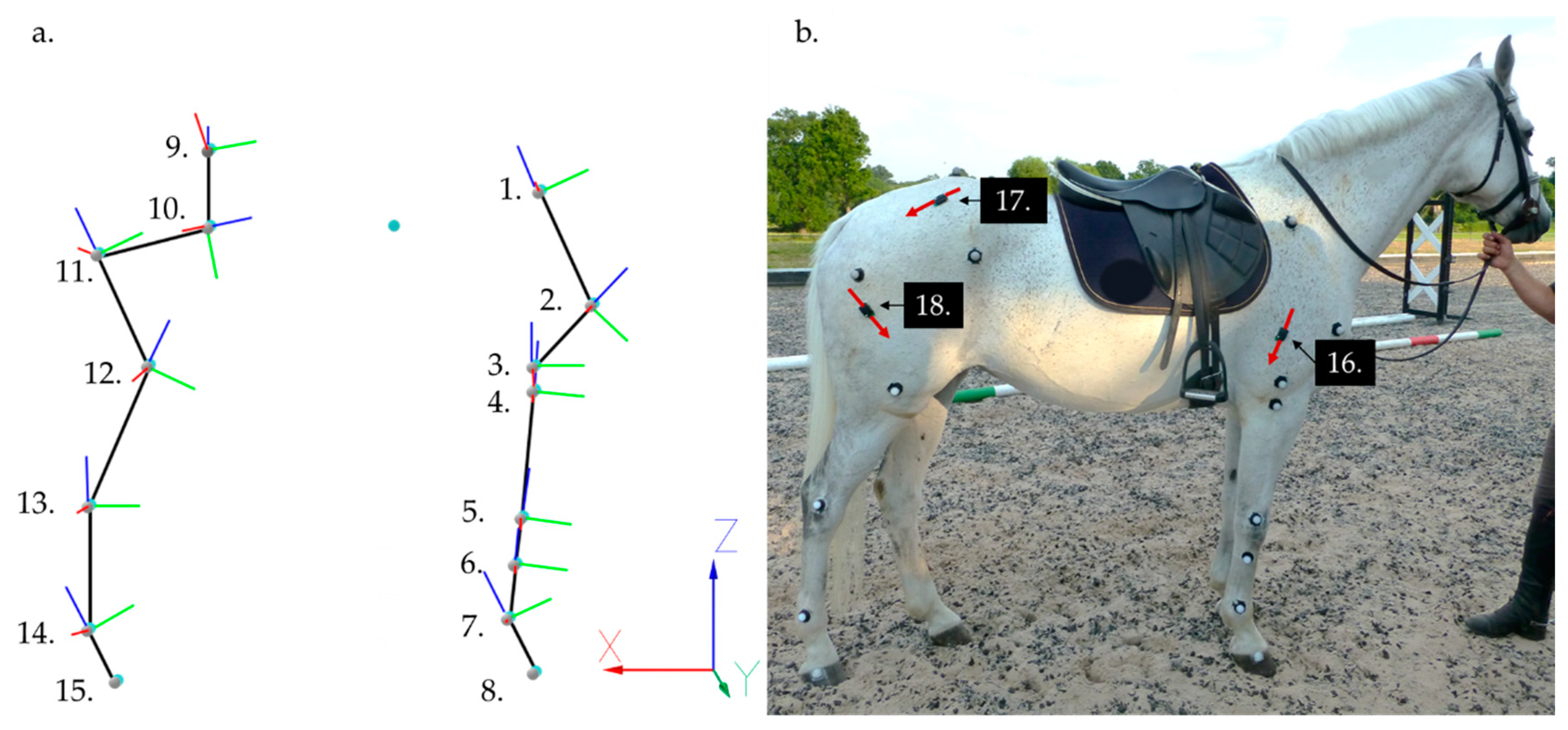
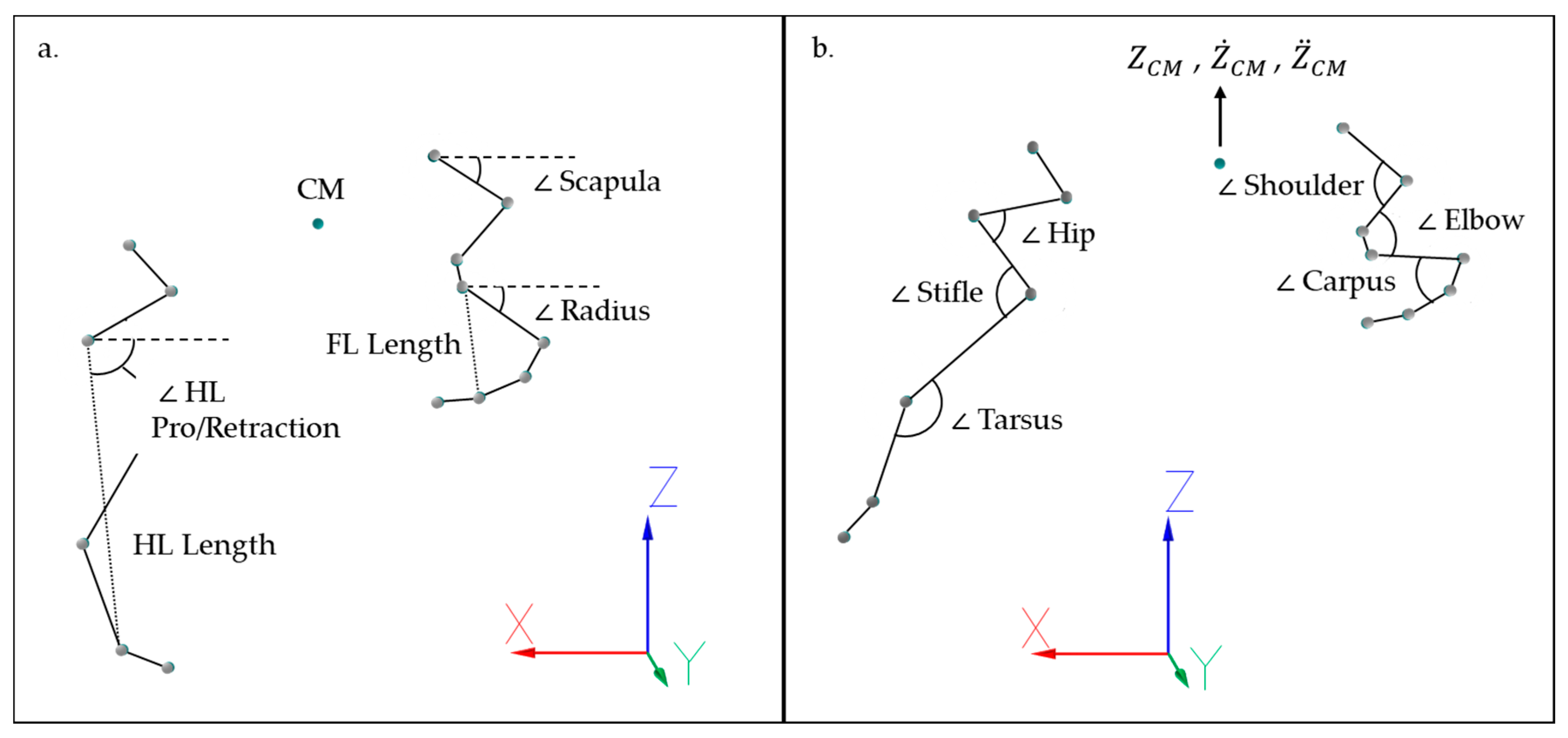
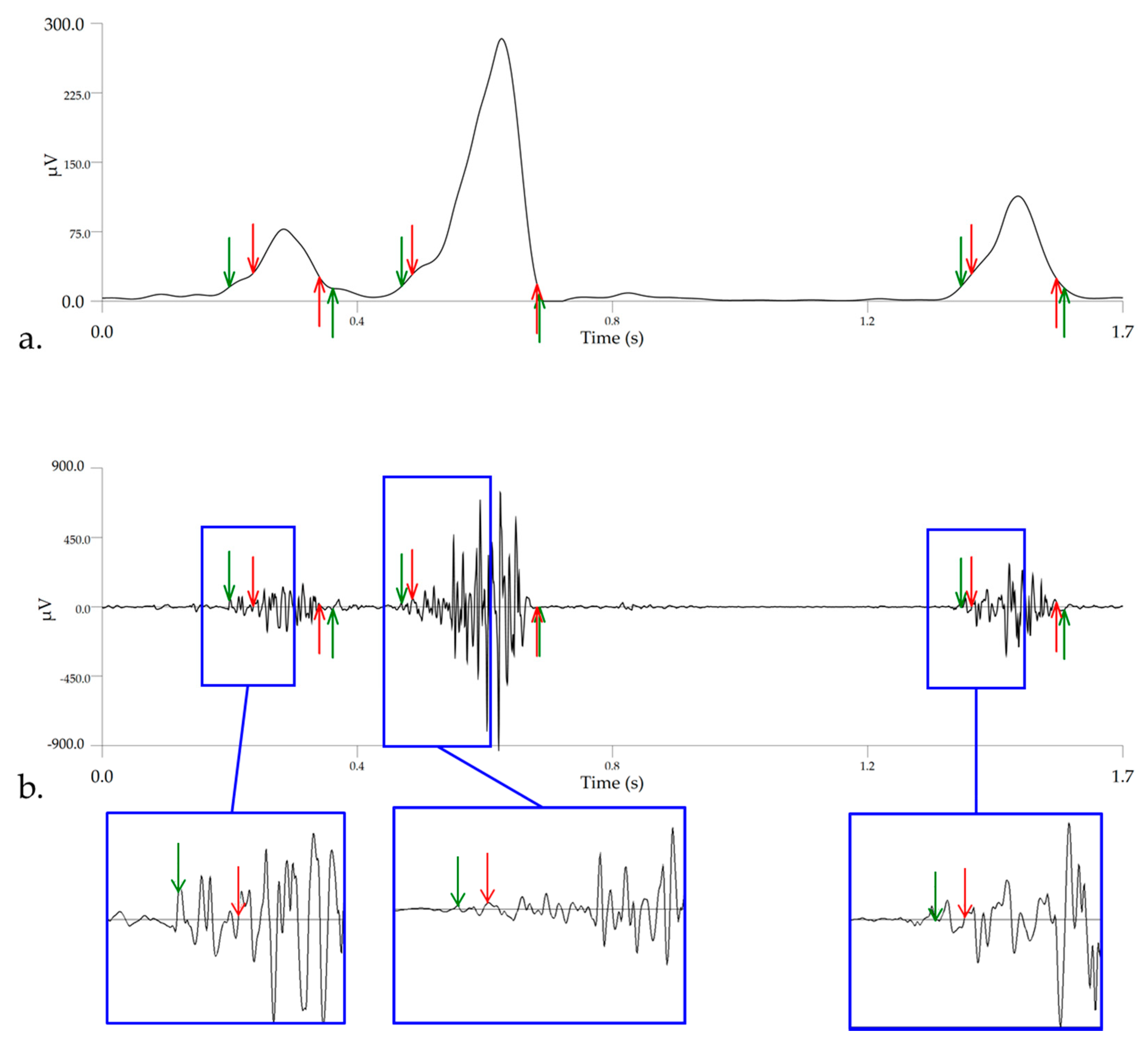
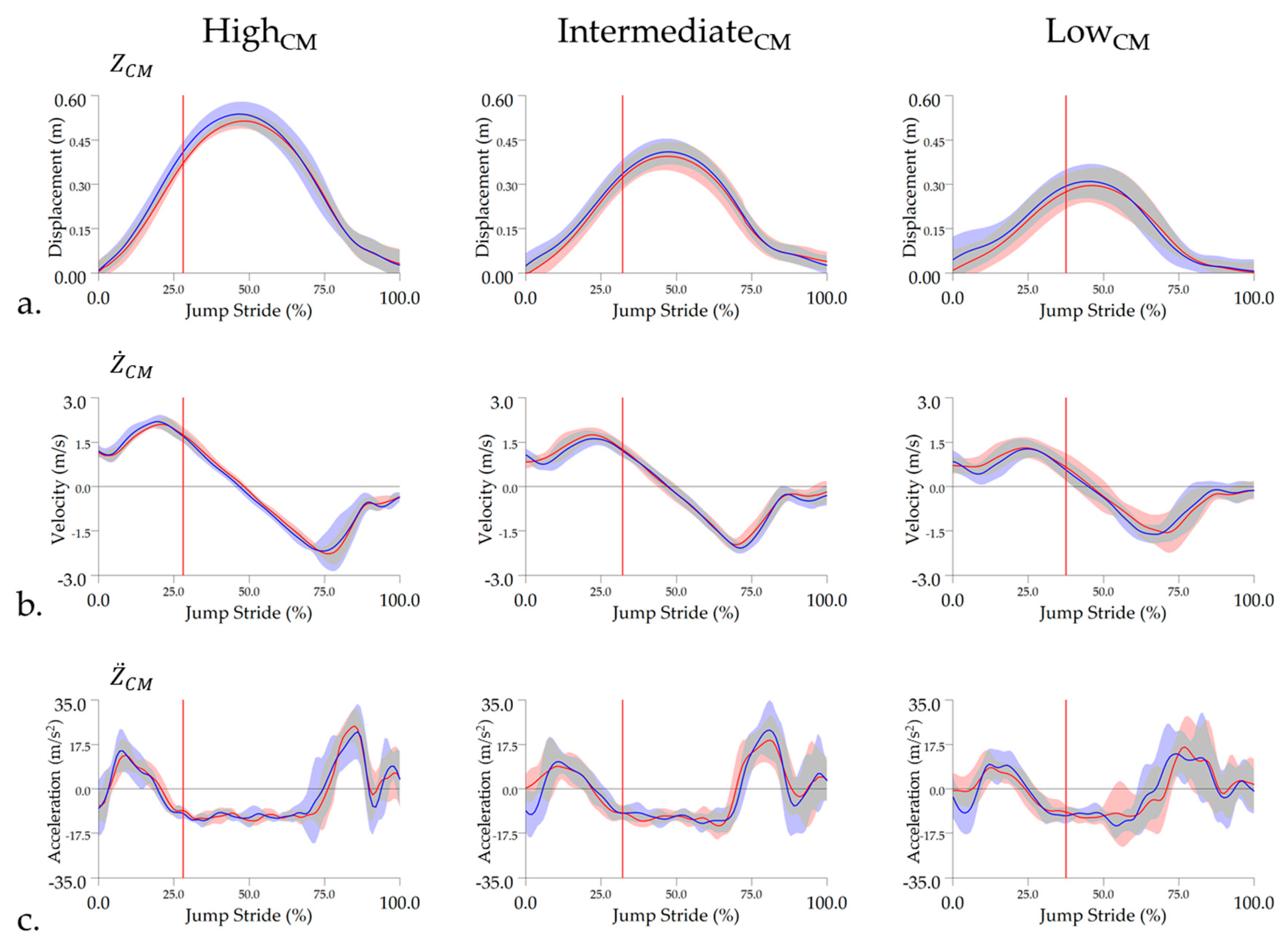
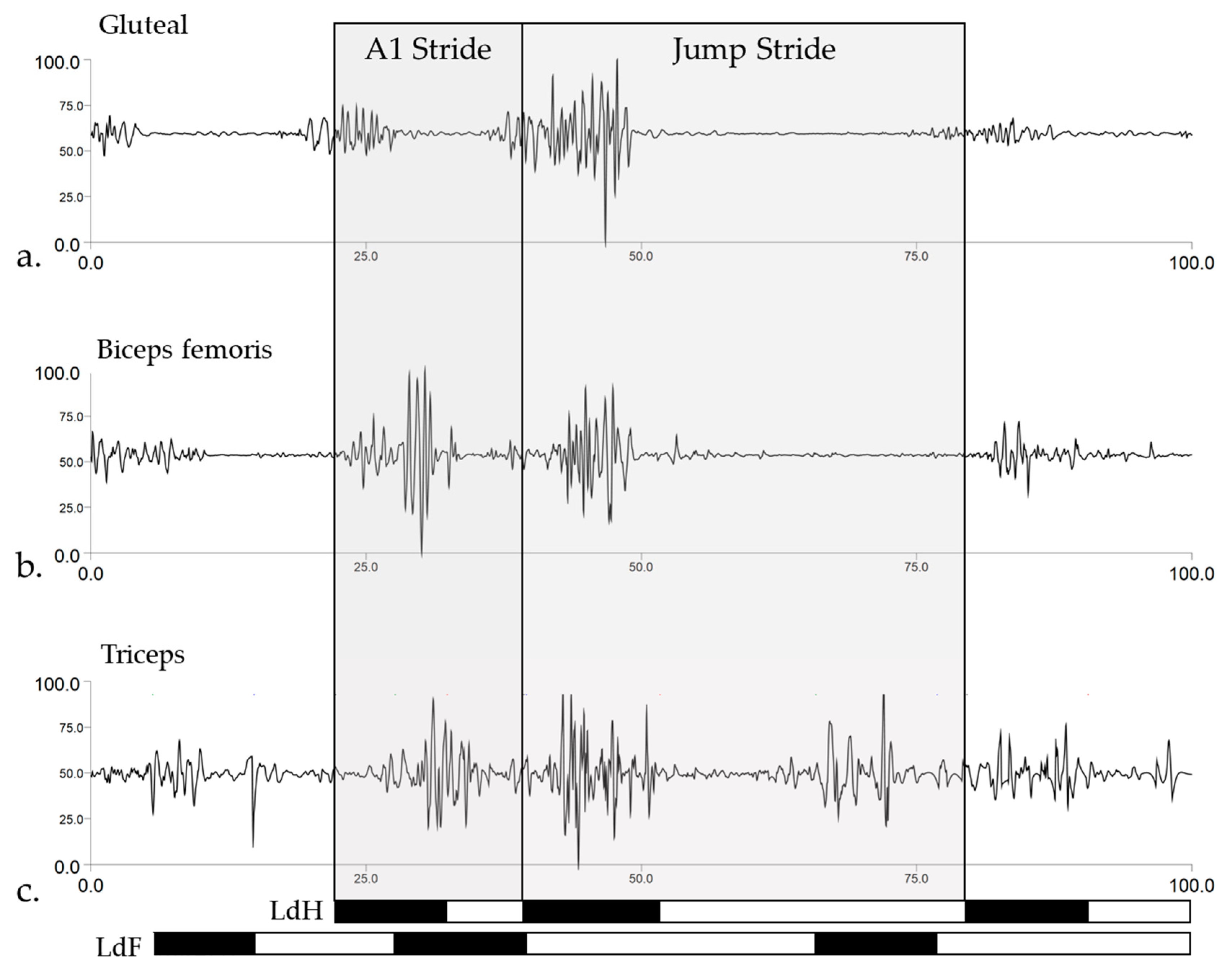
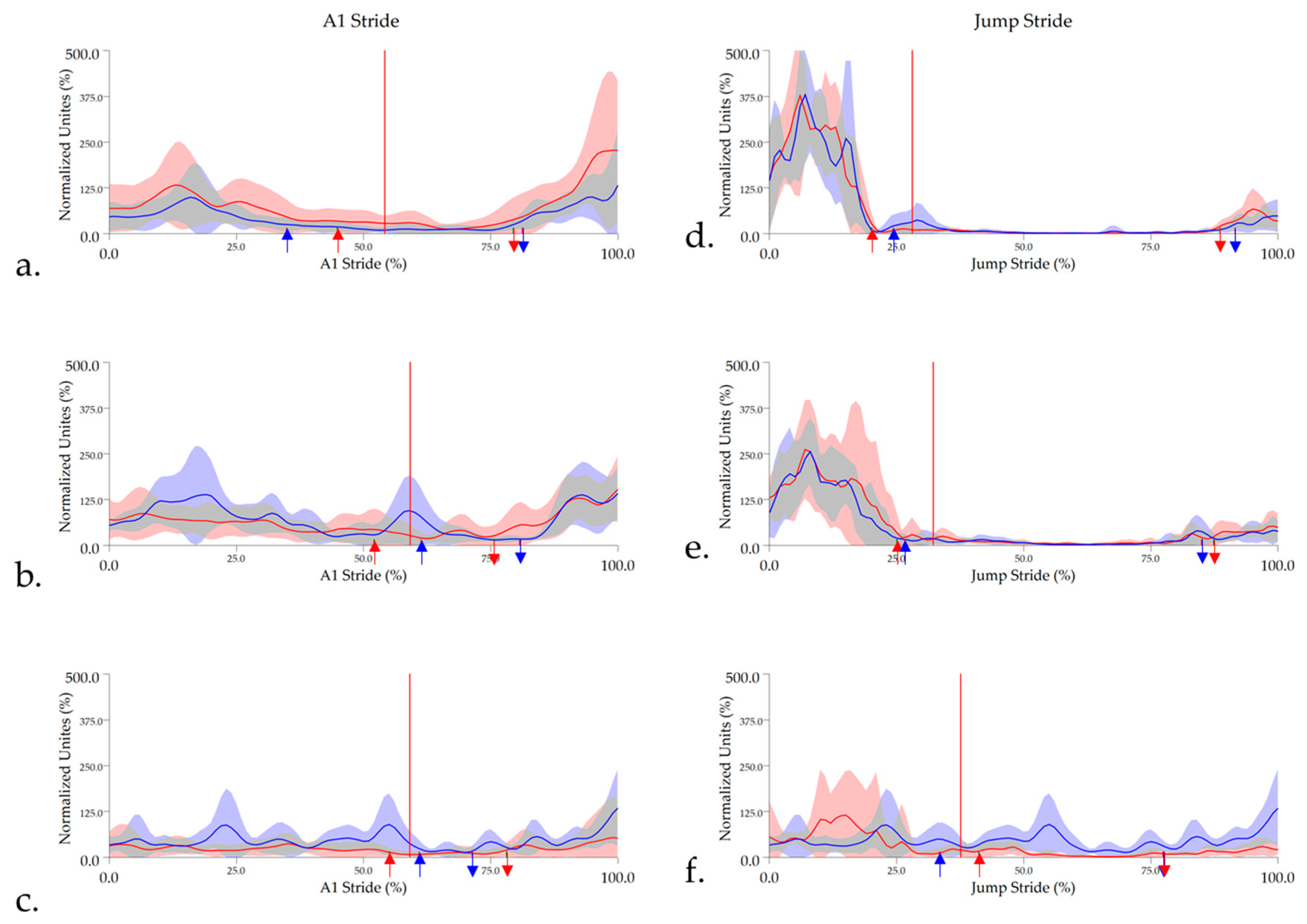
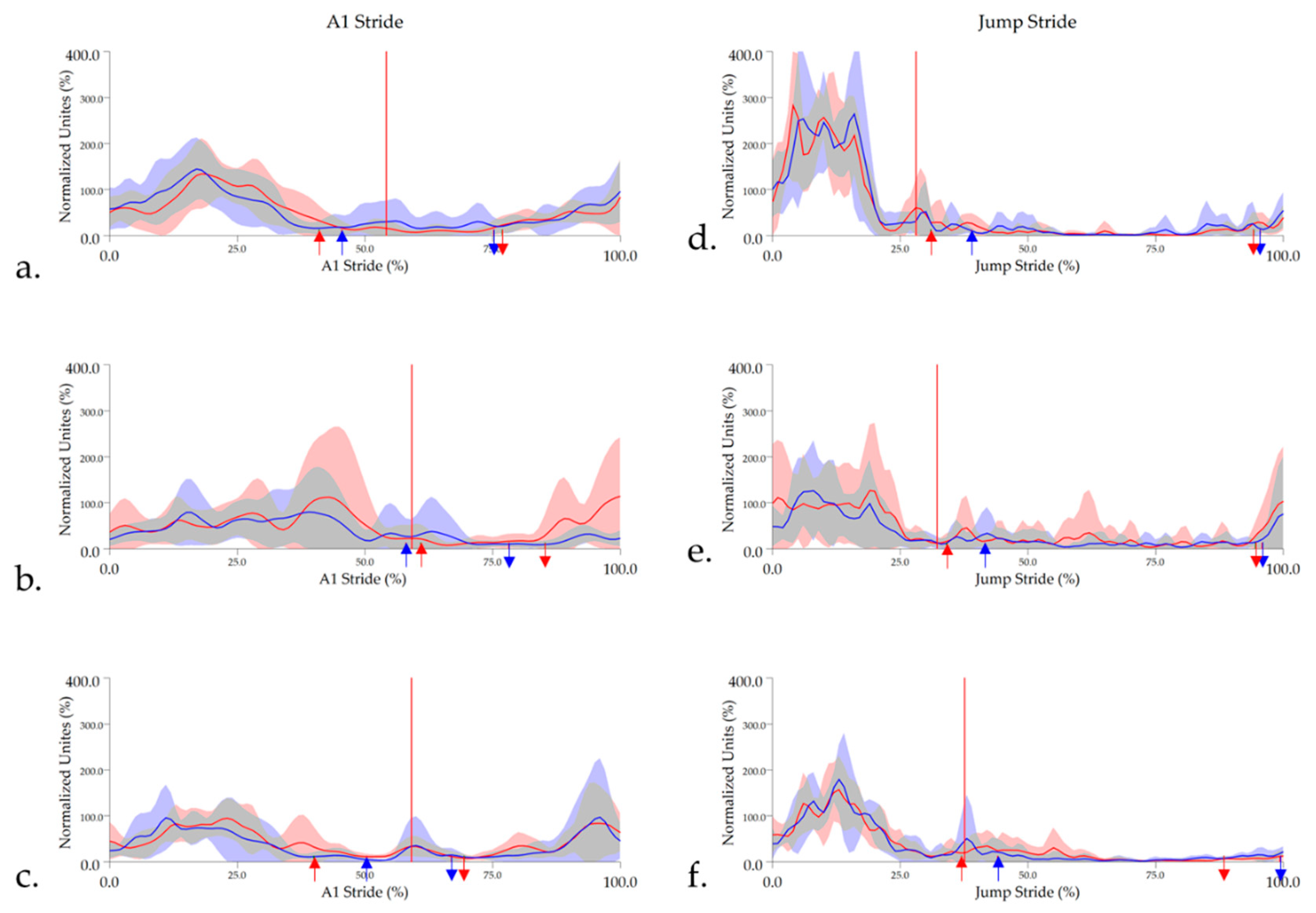

| Theme | Kinematic Variable | Limb | Group | p | eta2 | ||
|---|---|---|---|---|---|---|---|
| HighCM | Int.CM | LowCM | |||||
| Joint Articulation | Max shoulder flex (°) | TrF | 10.8 ± 2.2 | 11.4 ± 6.0 | 8.6 ± 3.3 | 0.58 | 0.08 |
| LdF | 12.3 ± 1.8 | 11.7 ± 3.9 | 8.8 ± 3.1 | 0.22 | 0.20 | ||
| Max shoulder flex time (% jump stride) | TrF | 19.2 ± 2.1 | 20.8 ± 9.9 | 23.6 ± 6.0 | 0.67 | 0.06 | |
| LdF | 17.0 ± 4.5 | 21.5 ± 4.2 | 25.2 ± 6.2 | 0.18 | 0.27 | ||
| Max scapula angle (°) | TrF | 55.3 ± 6.7 | 49.3 ± 8.3 | 44.2 ± 8.3 | 0.15 | 0.25 | |
| LdF | 53.2 ± 3.2 | 49.1 ± 8.5 | 40.8 ± 8.9 | 0.06 | 0.34 | ||
| Max scapula angle time (% jump stride) | TrF | 19.1 ± 0.7 a | 23.1 ± 3.5 | 23.6 ± 1.1 a | 0.03 | 0.45 | |
| LdF | 19.3 ± 1.2 | 24.8 ± 4.7 | 23.3 ± 3.4 | 0.10 | 0.29 | ||
| Max FL shortening (m) | TrF | −0.5 ± 0.0 | −0.5 ± 0.0 | −0.5 ± 0.0 | 0.26 | 0.18 | |
| LdF | −0.5 ± 0.1 | −0.5 ± 0.0 | −0.5 ± 0.0 | 0.41 | 0.13 | ||
| Max FL shortening time (% jump stride) | TrF | 31.5 ± 4.7 | 27.6 ± 5.0 | 25.9 ± 8.3 | 0.43 | 0.13 | |
| LdF | 32.5 ± 2.1 | 28.0 ± 4.0 | 29.1 ± 11.7 | 0.77 | 0.05 | ||
| Max carpus flex (°) | TrF | 118.5 ± 9.0 | 128.3 ± 7.2 | 124.4 ± 14.9 | 0.37 | 0.17 | |
| LdF | 117.4 ± 5.6 | 130.7 ± 9.8 | 126.3 ± 16.1 | 0.21 | 0.21 | ||
| Max carpus flex time (% jump stride) | TrF | 28.6 ± 3.9 | 24.8 ± 1.5 | 25.6 ± 8.3 | 0.55 | 0.11 | |
| LdF | 31.1 ± 2.2 | 28.2 ± 4.5 | 23.3 ± 11.8 | 0.43 | 0.14 | ||
| Max elbow flex (°) | TrF | 81.0 ± 3.8 | 85.0 ± 7.9 | 87.0 ± 8.6 | 0.51 | 0.12 | |
| LdF | 78.0 ± 5.8 | 85.9 ± 6.8 | 81.0 ± 10.6 | 0.25 | 0.18 | ||
| Max elbow flex time (% jump stride) | TrF | 31.9 ± 13.0 | 35.5 ± 5.9 | 26.2 ± 9.5 | 0.38 | 0.18 | |
| LdF | 42.1 ± 2.1 | 37.6 ± 6.1 | 38.8 ± 6.6 | 0.67 | 0.08 | ||
| Max radius angle (°) | TrF | 76.6 ± 5.0 | 82.8 ± 8.3 | 75.8 ± 7.7 | 0.26 | 0.20 | |
| LdF | 75.3 ± 7.5 | 82.2 ± 4.8 a | 71.9 ± 7.5 a | 0.04 | 0.37 | ||
| Max radius angle time (% jump stride) | TrF | 41.0 ± 3.7 | 36.0 ± 8.4 | 27.3 ± 12.3 | 0.13 | 0.31 | |
| LdF | 39.9 ± 10.4 | 40.0 ± 6.9 | 41.9 ± 7.2 | 0.91 | 0.02 | ||
| Max HL shortening (m) | TrH | −0.4 ± 0.1 | −0.4 ± 0.1 | −0.4 ± 0.1 | 0.35 | 0.15 | |
| LdH | −0.4 ± 0.0 | −0.4 ± 0.1 | −0.4 ± 0.1 | 0.41 | 0.12 | ||
| Max HL shortening time (% jump stride) | TrH | 79.6 ± 7.1 | 80.6 ± 7.0 | 84.3 ± 4.4 | 0.50 | 0.11 | |
| LdH | 68.5 ± 11.8 a | 80.4 ± 6.0 | 83.7 ± 4.5 a | 0.02 | 0.44 | ||
| Max HL retraction (°) | TrH | −50.2 ± 0.9 | −46.0 ± 2.7 a | −52.5 ± 3.4 a | 0.00 | 0.58 | |
| LdH | −48.4 ± 4.3 | −45.6 ± 5.6 a | −54.3 ± 3.8 a | 0.02 | 0.41 | ||
| Max HL retraction time (% jump stride) | TrH | 70.2 ± 2.6 | 72.6 ± 2.6 | 70.6 ± 1.5 | 0.25 | 0.21 | |
| LdH | 71.3 ± 1.3 | 72.2 ± 3.1 | 68.5 ± 3.9 | 0.16 | 0.25 | ||
| Impulsion | HL A1 stance duration (s) | TrH | 0.2 ± 0.0 | 0.2 ± 0.0 | 0.2 ± 0.0 | 0.07 | 0.41 |
| LdH | 0.2 ± 0.0 a | 0.2 ± 0.0 | 0.3 ± 0.0 a | 0.04 | 0.42 | ||
| FL A1 stance duration (s) | TrF | 0.2 ± 0.0 a | 0.2 ± 0.0 b | 0.3 ± 0.0 a,b | 0.01 | 0.51 | |
| LdF | 0.2 ± 0.0 a | 0.2 ± 0.0 | 0.3 ± 0.0 a | 0.02 | 0.44 | ||
| HL jump stance duration (s) | TrH | 0.2 ± 0.0 | 0.2 ± 0.0 | 0.3 ± 0.0 | 0.11 | 0.29 | |
| LdH | 0.2 ± 0.0 | 0.2 ± 0.0 | 0.3 ± 0.0 | 0.07 | 0.33 | ||
| Duty factor (% A1 stride) | TrH * | 52.1 ± 4.6 | 58.4 ± 4.7 | 57.3 ± 2.3 | 0.10 | 0.37 | |
| LdH | 55.3 ± 7.2 | 59.1 ± 2.4 | 59.5 ± 1.9 | 0.35 | 0.17 | ||
| Duty factor (% jump stride) | TrH | 27.7 ± 4.8 a | 31.5 ± 3.8 | 36.7 ± 4.3 a | 0.02 | 0.47 | |
| LdH | 29.5 ± 4.9 a | 32.2 ± 3.2 | 37.6 ± 3.5 a | 0.02 | 0.47 | ||
| ZCM (m) | TrH | 0.5 ± 0.0 a,b | 0.4 ± 0.0 a,c | 0.3 ± 0.1 b,c | 0.00 | 0.78 | |
| LdH | 0.5 ± 0.0 a,b | 0.4 ± 0.1 a,c | 0.3 ± 0.0 b,c | 0.00 | 0.81 | ||
| ZCM time (% jump stride) | TrH | 46.4 ± 1.7 | 47.5 ± 2.1 | 44.9 ± 3.3 | 0.25 | 0.21 | |
| LdH | 47.5 ± 2.2 | 46.9 ± 3.8 | 45.0 ± 5.1 | 0.57 | 0.08 | ||
| (m/s) | TrH | 2.1 ± 0.2 a | 1.8 ± 0.3 | 1.4 ± 0.3 a | 0.00 | 0.57 | |
| LdH | 2.2 ± 0.1 a | 1.8 ± 0.3 b | 1.4 ± 0.3 a,b | 0.00 | 0.62 | ||
| time (% jump stride) | TrH | 19.1 ± 1.9 a | 22.3 ± 4.3 | 25.2 ± 1.0 a | 0.03 | 0.43 | |
| LdH | 21.0 ± 3.0 | 22.5 ± 2.4 | 23.9 ± 3.9 | 0.43 | 0.13 | ||
| (m/s2) | TrH | 17.0 ± 6.6 | 17.8 ± 6.2 | 14.6 ± 2.7 | 0.61 | 0.07 | |
| LdH | 16.8 ± 3.5 | 15.9 ± 4.0 | 12.7 ± 2.1 | 0.16 | 0.23 | ||
| time (% jump stride) | TrH | 8.0 ± 1.6a | 11.1 ± 3.2 | 14.7 ± 2.4a | 0.01 | 0.55 | |
| LdH | 9.9 ± 1.7 | 11.4 ± 4.2 | 13.7 ± 3.8 | 0.37 | 0.15 | ||
| A1 stride vel (m/s) | TrH | 6.5 ± 0.6a | 6.1 ± 0.4 | 5.5 ± 0.5a | 0.04 | 0.49 | |
| LdH | 6.6 ± 0.5 | 6.2 ± 0.3 | 5.8 ± 0.6 | 0.05 | 0.37 | ||
| Jump stride vel (m/s) | TrH * | 6.7 ± 0.7 | 6.3 ± 0.3 | 5.7 ± 0.7 | 0.04 | 0.41 | |
| LdH * | 6.6 ± 0.2 | 6.5 ± 0.3 | 5.9 ± 0.7 | 0.10 | 0.30 | ||
| Engagement | Max hock flex take-off (°) | TrH | 31.2 ± 2.0 | 33.2 ± 7.1 | 32.2 ± 6.4 | 0.87 | 0.02 |
| LdH | 26.5 ± 6.4 | 33.5 ± 7.8 | 29.4 ± 7.7 | 0.30 | 0.16 | ||
| Max hock flex take-off time (% jump stride) | TrH | 11.8 ± 1.1 a | 14.1 ± 3.1 | 16.1 ± 1.0 a | 0.04 | 0.42 | |
| LdH | 12.3 ± 0.7 | 14.4 ± 3.0 | 16.6 ± 2.8 | 0.08 | 0.32 | ||
| Max stifle flex take-off (°) | TrH * | 28.6 ± 3.9 | 31.5 ± 5.9 | 34.1 ± 6.1 | 0.37 | 0.14 | |
| LdH * | 28.0 ± 5.4 | 28.7 ± 6.0 | 29.1 ± 8.9 | 0.97 | 0.01 | ||
| Max stifle flex take-off time (% jump stride) | TrH | 14.6 ± 0.9 a | 17.5 ± 3.0 | 19.8 ± 1.7 a | 0.02 | 0.50 | |
| LdH | 15.3 ± 1.7 a | 18.3 ± 2.3 | 19.8 ± 2.4 a | 0.03 | 0.43 | ||
| Max hip flex take-off (°) | TrH | −2.9 ± 1.3 | −5.2 ± 3.0 | −5.1 ± 1.8 | 0.29 | 0.17 | |
| LdH | −2.1 ± 4.2 | −3.3 ± 1.9 | −4.0 ± 2.2 | 0.57 | 0.08 | ||
| Max hip flex take-off time (% jump stride) | TrH | 11.2 ± 1.8 | 13.0 ± 2.8 | 12.3 ± 1.3 | 0.44 | 0.13 | |
| LdH | 12.3 ± 3.3 | 13.1 ± 1.8 | 14.0 ± 2.0 | 0.57 | 0.08 | ||
| Max HL shortening take-off (m) | TrH | −0.2 ± 0.0 | −0.1 ± 0.0 | −0.1 ± 0.0 | 0.08 | 0.32 | |
| LdH | −0.2 ± 0.0 | −0.1 ± 0.0 | −0.1 ± 0.0 | 0.75 | 0.04 | ||
| Max HL shortening take-off time (% jump stride) | TrH | 11.5 ± 0.6 a | 14.5 ± 2.8 | 16.5 ± 1.5 a | 0.01 | 0.54 | |
| LdH | 12.3 ± 0.9 | 15.1 ± 2.2 | 16.2 ± 1.8 | 0.05 | 0.42 | ||
| Max HL protraction A1 stride (°) | TrH | 22.2 ± 1.5 | 21.0 ± 3.4 | 20.5 ± 3.7 | 0.72 | 0.05 | |
| LdH | 20.1 ± 2.5 | 20.0 ± 6.8 | 22.4 ± 4.2 | 0.68 | 0.06 | ||
| Muscle | Stride | sEMG Variable (% stride) | Limb | Group | p | eta2 | ||
|---|---|---|---|---|---|---|---|---|
| HighCM | Int.CM | LowCM | ||||||
| Middle gluteal | A1 | Peak amplitude | TrH | 8.1 ± 11.5 | 19.4 ± 19.5 | 20.5 ± 28.6 | 0.65 | 0.10 |
| LdH | 11.5 ± 6.5 | 16.7 ± 19.2 | 17.7 ± 17.2 | 0.78 | 0.05 | |||
| Activity duration | TrH | 55.4 ± 15.2 | 78.0 ± 14.5 | 70.0 ± 17.2 | 0.17 | 0.35 | ||
| LdH | 66.6 ± 16.3 | 80.3 ± 11.6 | 87.6 ± 18.8 | 0.20 | 0.30 | |||
| A1 activity offset | TrH | 35.4 ± 3.8 a,b | 57.9 ± 13.4 a | 61.8 ± 2.5 b | 0.02 | 0.70 | ||
| LdH | 44.9 ± 15.2 | 51.1 ± 20.4 | 55.8 ± 3.0 | 0.70 | 0.10 | |||
| Take-off activity onset | TrH | 81.4 ± 4.7 | 79.9 ± 4.9 | 71.2 ± 25.1 | 0.59 | 0.13 | ||
| LdH | 79.5 ± 4.3 | 76.5 ± 9.2 | 83.0 ± 20.8 | 0.77 | 0.07 | |||
| Jump | Peak amplitude | TrH | 6.7 ± 5.1 | 7.0 ± 1.9 | 9.2 ± 4.2 | 0.63 | 0.10 | |
| LdH | 8.5 ± 2.5 | 10.6 ± 7.2 | 11.6 ± 2.2 | 0.67 | 0.76 | |||
| Activity duration | TrH | 31.1 ± 9.4 a | 46.2 ± 11.8 | 61.6 ± 16.9 a | 0.03 | 0.55 | ||
| LdH | 28.1 ± 6.9 a | 43.3 ± 14.6 | 67.4 ± 18.4 a | 0.01 | 0.61 | |||
| Take-off activity offset | TrH | 24.3 ± 7.3 | 25.9 ±9.5 | 34.9 ± 17.3 | 0.44 | 0.17 | ||
| LdH | 20.2 ± 1.7 | 26.8 ±7.6 | 39.2 ± 17.2 | 0.08 | 0.40 | |||
| Landing activity onset | TrH | 91.6 ± 3.0 a | 82.8 ± 7.8 | 76.9 ± 3.4 a | 0.02 | 0.61 | ||
| LdH | 89.5 ± 3.7 a | 87.9 ± 6.0 | 77.6 ± 5.1 a | 0.03 | 0.56 | |||
| Biceps femoris | A1 | Peak amplitude | TrH | 16.8 ± 3.8 | 33.2 ± 13.2 | 16.7 ± 1.5 | 0.07 | 0.53 |
| LdH | 23.4 ± 4.2 | 35.3 ± 16.9 | 24.5 ± 11.4 | 0.30 | 0.22 | |||
| Activity duration | TrH | 73.2 ± 15.6 | 73.6 ± 10.3 | 71.4 ± 5.6 | 0.98 | 0.01 | ||
| LdH | 70.3 ± 7.7 | 81.5 ± 10.0 | 78.5 ± 14.8 | 0.26 | 0.24 | |||
| A1 activity offset | TrH * | 40.0 ± 4.0 a | 58.0 ± 10.4 a | 40.7 ± 4.7 | 0.02 | 0.66 | ||
| LdH * | 45.4 ± 3.5 | 60.2 ± 16.5 | 49.6 ± 11.4 | 0.18 | 0.29 | |||
| Take-off activity onset | TrH | 72.5 ± 16.3 | 84.4 ± 7.7 | 69.3 ± 0.9 | 0.29 | 0.30 | ||
| LdH | 75.2 ± 10.8 | 78.6 ± 10.6 | 71.1 ± 7.4 | 0.62 | 0.09 | |||
| Jump | Peak amplitude | TrH | 9.5 ± 3.0 | 8.0 ± 3.8 | 12.1 ± 0.5 | 0.24 | 0.27 | |
| LdH | 9.4 ± 3.3 | 10.8 ± 7.3 | 11.5 ± 1.9 | 0.86 | 0.03 | |||
| Activity duration | TrH | 36.9 ± 10.9 | 41.6 ± 11.3 | 47.9 ± 9.9 | 0.45 | 0.16 | ||
| LdH | 40.9 ± 15.8 | 45.7 ± 12.9 | 39.2 ± 16.7 | 0.79 | 0.05 | |||
| Take-off activity offset | TrH * | 31.0 ± 9.6 | 35.7 ± 12.0 | 36.4 ± 15.5 | 0.80 | 0.05 | ||
| LdH * | 37.0 ± 13.0 | 41.6 ± 11.8 | 35.5 ± 20.1 | 0.80 | 0.04 | |||
| Landing activity onset | TrH | 94.1 ± 4.6 | 94.6 ± 3.5 | 88.8 ± 6.3 | 0.24 | 0.27 | ||
| LdH | 97.2 ± 6.2 | 97.1 ± 7.5 | 97.1 ± 6.0 | 1.00 | 0.00 | |||
| Triceps brachii | A1 | Peak amplitude | TrF | 49.6 ± 23.7 | 56.7 ± 28.8 | 40.1 ± 21.4 | 0.78 | 0.09 |
| LdF | 56.7 ± 14.2 | 63.5 ± 8.1 | 62.5 ± 34.0 | 0.83 | 0.04 | |||
| Activity duration | TrF | 91.2 ± 15.2 | 71.2 ± 20.7 | 87.01 ± 0.9 | 0.37 | 0.33 | ||
| LdF | 90.3 ± 13.3 | 65.4 ± 21.0 | 93.6 ± 5.5 | 0.05 | 0.46 | |||
| A1 activity offset | TrF | 55.8 ± 3.7 | 59.4 ± 13.1 | 71.0 ± 22.6 | 0.72 | 0.28 | ||
| LdF | 74.7 | 65.9 ± 8.9 | 76.8 ± 0.5 | 0.36 | 0.50 | |||
| Take-off activity onset | TrF | 76.5 ± 1.7 | 79.0 ± 1.9 | 66.01 | 0.06 | 0.94 | ||
| LdF | 73.9 ± 17.6 | 86.3 ± 0.6 | 0.40 | 0.18 | ||||
| Jump | Peak amplitude | TrF | 71.8 ± 19.3 | 75.3 ± 8.7 | 73.4 ± 8.0 | 0.94 | 0.02 | |
| LdF | 61.0 ± 44.1 | 56.0 ± 34.4 | 70.5 ± 4.8 | 0.83 | 0.04 | |||
| Activity duration | TrF | 54.9 ± 22.7 | 55.3 ± 7.8 | 70.2 ± 0.9 | 0.31 | 0.28 | ||
| LdF | 45.2 ± 9.4 | 62.7 ± 16.9 | 60.6 ± 12.8 | 0.26 | 0.25 | |||
| FL take-off activity offset | TrF | 21.3 ± 4.6 | 14.2 ± 8.8 | 21.3 ± 9.0 | 0.44 | 0.24 | ||
| LdF | 15.4 ± 11.3 | 18.8 ± 11.1 | 11.9 ± 3.8 | 0.65 | 0.10 | |||
| FL landing activity onset | TrF | 61.5 ± 10.9 | 58.1 ± 2.0 | 48.1 ± 19.0 | 0.40 | 0.23 | ||
| LdF | 66.1 ± 5.3 | 58.0 ± 4.0 | 58.0 ± 10.3 | 0.16 | 0.37 | |||
| Kinematic Variable | Limb | Gluteal A1 Offset | Gluteal Jump Duration | Gluteal Jump Landing Onset | Biceps Femoris A1 Offset | ||||
|---|---|---|---|---|---|---|---|---|---|
| TrH | LdH | TrH | LdH | TrH | LdH | TrH | LdH | ||
| Max stifle flex take-off time (% jump stride) | TrH | 0.29 | −0.03 | 0.47 | 0.45 | −0.47 | −0.50 | −0.38 | −0.44 |
| LdH | 0.15 | 0.01 | 0.58 | 0.60 * | −0.37 | −0.42 | −0.02 | 0.02 | |
| Max HL retraction (°) | TrH | 0.02 | 0.16 | −0.22 | −0.31 | 0.02 | 0.52 | 0.79 ** | 0.45 |
| LdH | −0.15 | 0.10 | −0.36 | −0.50 | 0.13 | 0.52 | 0.83 ** | 0.37 | |
| ZCM (m) | TrH | −0.56 | −0.17 | −0.71 * | −0.65 * | 0.65 * | 0.67 * | 0.10 | 0.12 |
| LdH | −0.63 | −0.11 | −0.76 ** | −0.78 ** | 0.78 ** | 0.75 ** | 0.13 | 0.08 | |
| (m/s) | TrH | −0.41 | 0.15 | −0.64 * | −0.60 * | 0.67 * | 0.57 | 0.18 | 0.27 |
| LdH | −0.48 | −0.03 | −0.65 * | −0.65 * | 0.65 * | 0.60 * | 0.25 | 0.21 | |
| time (% jump stride) | TrH | 0.12 | 0.08 | 0.25 | 0.23 | −0.43 | −0.28 | −0.20 | −0.38 |
| LdH | −0.11 | 0.08 | −0.07 | −0.04 | 0.05 | 0.09 | −0.04 | −0.03 | |
| time (% jump stride) | TrH | 0.22 | 0.14 | 0.48 | 0.43 | −0.47 | −0.36 | −0.29 | −0.36 |
| LdH | −0.19 | −0.36 | −0.07 | −0.11 | 0.11 | 0.06 | −0.25 | −0.33 | |
| Max hock flex take-off time (% jump stride) | TrH | 0.16 | −0.23 | 0.42 | 0.43 | −0.50 | −0.43 | −0.33 | −0.44 |
| LdH | 0.01 | 0.04 | 0.31 | 0.38 | −0.11 | −0.40 | −0.12 | −0.12 | |
| Max HL shortening time (% jump stride) | TrH | 0.24 | 0.36 | 0.60 * | 0.62 * | 0.01 | −0.66 * | −0.34 | −0.01 |
| LdH | 0.53 | 0.25 | 0.58 | 0.62 * | −0.03 | −0.54 | 0.06 | 0.27 | |
| Max HL shortening take-off time (% jump stride) | TrH | 0.30 | 0.04 | 0.41 | 0.41 | −0.47 | −0.44 | −0.24 | −0.39 |
| LdH | 0.15 | 0.03 | 0.34 | 0.36 | −0.35 | −0.21 | −0.06 | −0.18 | |
| HL A1 stance (s) | TrH | 0.58 | 0.53 | 0.40 | 0.43 | −0.61 | −0.47 | −0.13 | −0.07 |
| LdH | 0.62 | 0.53 | 0.36 | 0.35 | −0.78 * | −0.32 | −0.02 | −0.01 | |
| A1 stride velocity (m/s) | TrH | 0.55 | 0.43 | 0.52 | 0.72 * | −0.82 * | −0.61 | −0.16 | −0.15 |
| LdH | 0.46 | 0.11 | 0.24 | 0.43 | −0.61 | −0.22 | −0.19 | −0.14 | |
| Duty factor (% jump stride) | TrH | 0.24 | −0.05 | 0.39 | 0.54 | −0.69 * | −0.46 | −0.23 | −0.27 |
| LdH | 0.07 | −0.14 | 0.32 | 0.58 * | −0.48 | −0.44 | −0.26 | −0.10 | |
Publisher’s Note: MDPI stays neutral with regard to jurisdictional claims in published maps and institutional affiliations. |
© 2021 by the authors. Licensee MDPI, Basel, Switzerland. This article is an open access article distributed under the terms and conditions of the Creative Commons Attribution (CC BY) license (http://creativecommons.org/licenses/by/4.0/).
Share and Cite
St. George, L.; Clayton, H.M.; Sinclair, J.; Richards, J.; Roy, S.H.; Hobbs, S.J. Muscle Function and Kinematics during Submaximal Equine Jumping: What Can Objective Outcomes Tell Us about Athletic Performance Indicators? Animals 2021, 11, 414. https://doi.org/10.3390/ani11020414
St. George L, Clayton HM, Sinclair J, Richards J, Roy SH, Hobbs SJ. Muscle Function and Kinematics during Submaximal Equine Jumping: What Can Objective Outcomes Tell Us about Athletic Performance Indicators? Animals. 2021; 11(2):414. https://doi.org/10.3390/ani11020414
Chicago/Turabian StyleSt. George, Lindsay, Hilary M. Clayton, Jonathan Sinclair, James Richards, Serge H. Roy, and Sarah Jane Hobbs. 2021. "Muscle Function and Kinematics during Submaximal Equine Jumping: What Can Objective Outcomes Tell Us about Athletic Performance Indicators?" Animals 11, no. 2: 414. https://doi.org/10.3390/ani11020414
APA StyleSt. George, L., Clayton, H. M., Sinclair, J., Richards, J., Roy, S. H., & Hobbs, S. J. (2021). Muscle Function and Kinematics during Submaximal Equine Jumping: What Can Objective Outcomes Tell Us about Athletic Performance Indicators? Animals, 11(2), 414. https://doi.org/10.3390/ani11020414










